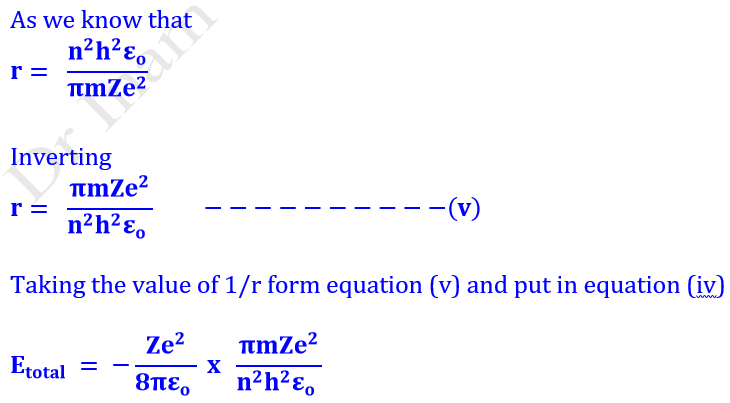Derivation of Radius of the nth Bohr’s Orbit for Hydrogen-Like Atoms
Assumptions for simple atom
To derive an expression for radius, consider a
hydrogen atom (or hydrogen-like atoms such as He+, Li2+,
Be3+, B4+, C5+) with atomic number equal to z consisting of a single electron with
charge –e and mass m revolving around the nucleus of charge +Ze
(+e is charge of proton) with a tangential velocity v
in the orbit whose radius is r.
Now revolving electron is being acted upon
simultaneously by the following two types of forces;
(i) Electrostatic force of Attraction / Centripetal Force
According to Coulomb’s law, the electrostatic force
of attraction (Fe) between the nucleus of charge ‘+Ze’ and electron
of charge ‘–e’ separated by a distance ‘r’ is given by:
Where ‘K’ is
proportionality constant. It is equal to 1/4πεor2
Hence attractive force between nucleus and electron can be written as
(ii) Centrifugal Force
This Coulombic force of (Fc) supplies the
centrifugal force to keep the electron in an orbit and is given by:
Equating Fe and Fc
To keep the electron in the same orbit, these two
opposite forces must be equal to each other i.e.
Determination of v2 of electron by using Bohr’s Postulate
According to Bohr’s postulate, angular momentum of
electron revolving around the nucleus is an integral multiple of h/2p.
Calculation of Radius (r)
Substituting the value v2 from equation (ii) in equation (i)
Where
h = Planck’s constant = 6.625 x 10−34 J.s
me = Mass of electron = 9.11 x 10−31 kg
e = Charge of electron = 1.602 x 10−19 C
𝛆o = Vacuum
permittivity constant = 8.84 x 10−12 C2/J.m
Calculation of nth Bohr’s orbit (rn)
Assembling
all constants in equation (iii), we get
Where a is known as Bohr’s constant or Bohr radius and
its value is 0.529 x 10−8 cm or 0.529 Å or 0.0529nm or 52.9 pm. This is the radius
of the first orbit of H. This equation is used for the determination of nth
orbit of hydrogen atom and hydrogen like ions like He+, Li2+
etc.
The above equation shows that radius of orbit is directly proportional to the square of the principal quantum numbers (r α n2 i.e. 1, 2, 3, ……..) and inversely proportional to atomic number. As the value of n increases, the radius of the orbit will increase.
Derivation of Energy of the nth Bohr’s Orbit
Basic of Derivation
The total energy of an electron revolving in any orbit around the nucleus is the sum of kinetic energy and potential energy given by,
Etotal = K.E + PE ……………….(i)
Calculation
of K.E
The K.E. of electron with mass m revolving around the nucleus with
velocity v is given by the following expression;
Now the centrifugal and centripetal forces upon the revolving electron
are given as:
At uniform circular equilibrium motion, these two opposite forces must be
equal to each other i.e.
Calculation
of P.E.
P.E is the work done in bringing the electron
from infinity to a point at a distance r from nucleus and can be calculate as
P.E =work done = −force x
displacement = −Fe x r
Here negative sign indicates that P.E decreases when electron is brought form infinity to a point at a distance r. Here negative sign indicates a net attractive interaction, giving algebraically lower energy at shorter distance.
Calculation
of Total Energy
Etotal = K.E + PE
Here K is a factor assembled by various constant present in energy equation. Its value is 2.18 x 10−18 J/atom or 1312.8 kJ/mol
E is always negative. Negative sign shows that the electron is bound to the atom and energy must be spent in order to remove it from the orbit.
All energy states are bound states as the negative sign indicates. When n = 1; this corresponds to electron at the closest possible distance from the nucleus and at its lowest energy and is called ground state energy. All energy states with value of n higher than 1 are termed as excited states. When n = α then E = 0; which means that the system is unbound and the electron is free.
It should be noted that the energy is increasing as the n (orbits)
increasing; however the difference of energy between two orbits is decreasing.
Conclusion
If total energy = − x
Then
KE = + x
PE = − 2x
2.12 Expression for ∆E of electronic transition between orbits
Calculation of ∆E
Let E1 be the energy of n1 orbit and E2
is for n2 orbit. To calculate the energy emitted by atom in the form
of radiation when an electron jumps from a higher energy state n2 to
lower energy orbit n1; let us make use of the postulate of Bohr’s
model; according to which, the emitted energy is written as
Emitted energy = ∆E = E2 – E1
But,
This equation is used for determining the emission or
absorption of energy when electron jumps from one orbit to another
2.13 Expression for Frequency of electronic transition between orbits
Calculation of ∆E
Let E1 be the energy of n1 orbit and E2 is for n2 orbit. To calculate the energy emitted by atom in the form of radiation when an electron jumps from a higher energy state n2 to lower energy orbit n1; let us make use of the postulate of Bohr’s model; according to which, the emitted energy is written as
Emitted energy = ∆E = E2 – E1
But,
To calculate the frequency (u) of emitted radiations (or photons
there in); let us make use of the Bohr’s postulate; according to which:
hu = ∆E = E2 – E1
But
To calculate the frequency (u) of emitted radiations (or photons
there in); let us make use of the Bohr’s postulate; according to which:
hu = ∆E = E2 – E1
But
2.14 Expression for Wave Number and Wave
Length of Radiation






























